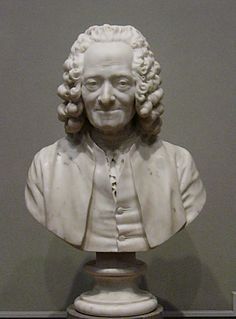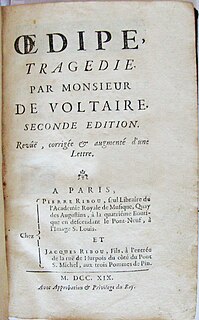

Brutus is a tragedy in five acts by Voltaire. He began work on the play in 1727 in England and completed it in 1729. It premiered on 11 December 1730 in Paris.


Brutus is a tragedy in five acts by Voltaire. He began work on the play in 1727 in England and completed it in 1729. It premiered on 11 December 1730 in Paris.
The first part of the work was written in English at Wandsworth while Voltaire was in England, and it was completed on his return to France. Two and a half years passed before he considered it ready for the stage. Voltaire's lover Adrienne Lecouvreur was meant to play the role of Tullie, but she fell ill and died during rehearsals and had to be replaced by Mlle Dangeville. [1] :14–19 She was only sixteen years old, and her nervousness did not help the reception of the play. [2]
Voltaire drew his material from the legendary story of the first Roman Consul Lucius Junius Brutus (509 BC). His son, Titus, falls in love with Tullie, daughter of the last Etruscan king of Rome, Lucius Tarquinius Superbus, and through this relationship is led into betraying Rome. The Senate hands Titus over to his father, who forgives him but insists on his execution to ensure the safety of the Republic. [3]
When the play premiered at the Comédie-Française on December 11, 1730, audience reaction was mixed. It was criticised for not adhering to the three unities and for the harsh attitude of the character of Brutus. Although the play was well-attended, it was taken off the stage after only fifteen performances. [4] The openly republican theme of the play displeased the authorities, and Voltaire's enemies Prosper Jolyot de Crébillon and the Chevalier de Rohan were actively trying to turn the public against it. [2] Voltaire left Paris to spend some time privately in Rouen. The play enjoyed a revival during the French Revolution, and the National Convention ordered a performance of Brutus on 2 August 1793 with free admission. [5] [4] in all there were 110 performances at the Comédie-Française between 1730 and 1799. [6]
The first edition was printed in 1731 with Jean-François Josse in Paris, together with a Discours sur la Tragédie by Voltaire, dedicated to Lord Bolingbroke. Thirteen individual editions followed during Voltaire's life, and between 1790 and 1794 twelve further editions were added. [3]

Pierre Corneille was a French tragedian. He is generally considered one of the three great seventeenth-century French dramatists, along with Molière and Racine.

Antoine Houdar de la Motte was a French author.

Lekain was the stage name of Henri Louis Cain, a French actor.

François Joseph Talma was a French actor.

Adrienne Lecouvreur, born Adrienne Couvreur, was a French actress, considered by many as the greatest of her time. Born in Damery, she first appeared professionally on the stage in Lille. After her Paris debut at the Comédie-Française in 1717, she was immensely popular with the public. Together with Michel Baron, she was credited for having developed a more natural, less stylized, type of acting.

Anne Françoise Elisabeth Lange was a French actress of the Comédie-Française and a "Merveilleuse" of the French Directory. Her stage name was Mademoiselle Lange.

18th-century French literature is French literature written between 1715, the year of the death of King Louis XIV of France, and 1798, the year of the coup d'État of Bonaparte which brought the Consulate to power, concluded the French Revolution, and began the modern era of French history. This century of enormous economic, social, intellectual and political transformation produced two important literary and philosophical movements: during what became known as the Age of Enlightenment, the Philosophes questioned all existing institutions, including the church and state, and applied rationalism and scientific analysis to society; and a very different movement, which emerged in reaction to the first movement; the beginnings of Romanticism, which exalted the role of emotion in art and life.

The musical scores to several operas by the French composer Jean-Philippe Rameau have been lost. They include two major tragédies en musique, Samson and Linus, and a one-act pastoral opera Lisis et Délie. The music to these pieces was substantially complete and was performed in rehearsal but for various reasons - including censorship in the case of Samson - they were never publicly staged. Rameau also wrote a divertissement for Alexis Piron's play Les courses de Tempé, which did appear at the theatre in 1734. The music to all these works has been almost completely lost, although there is evidence Rameau reused some of it in his later operas. Rameau also began other operatic projects, which were either abandoned at an early stage (Pandore) or broken up to form shorter works.

The Lictors Bring to Brutus the Bodies of His Sons is a work in oils by the French artist Jacques-Louis David. On a canvas of 146 square feet, this painting was first exhibited at the Paris Salon in 1789. The subject is the Roman leader Lucius Junius Brutus, founder of the Roman Republic, contemplating the fate of his sons. They had conspired to overthrow the republic and restore the monarchy, and Brutus himself was compelled to order their deaths. In doing so, Brutus became the heroic defender of the republic, at the cost of his own family. The painting was a bold allegory of civic virtue with immense resonance for the growing cause of republicanism. Its themes of virtue, sacrifice, and devotion to the nation sparked much controversy when it was unveiled in the politically charged era of the French Revolution.

Zaïre is a five-act tragedy in verse by Voltaire. Written in three weeks, it was given its first public performance on 13 August 1732 by the Comédie française in Paris. It was a great success with the Paris audiences and marked a turning away from tragedies caused by a fatal flaw in the protagonist's character to ones based on pathos. The tragic fate of its heroine is caused not through any fault of her own, but by the jealousy of her Muslim lover and the intolerance of her fellow Christians. Zaïre was notably revived in 1874 with Sarah Bernhardt in the title role, and it was the only one of Voltaire's plays to be performed by the Comédie française during the 20th century. The play was widely performed in Britain well into the 19th century in an English adaptation by Aaron Hill and was the inspiration for at least thirteen operas.

Oedipus is a tragedy by the French dramatist and philosopher Voltaire that was first performed in 1718. It was his first play and the first literary work for which he used the pen-name Voltaire.

L'Orphelin de la Chine is a 1753 French play by Voltaire based on The Orphan of Zhao, a thirteenth-century Chinese play attributed to Ji Junxiang.

Charles Palissot de Montenoy was an 18th-century French playwright, admirer and disciple of Voltaire and Antoine de Rivarol. Paradoxically, he was often denounced as a Counter-Enlightenment opponent to the parti philosophique, especially for his critic of Diderot and the Encyclopédistes. He is the author of the comedy, Les Philosophes, which was a huge success and caused a scandal in 1760.
Agathocle is the last dramatic tragedy by Voltaire. It was written by the 84-year-old author in 1777 almost simultaneously with the tragedy Irène, only months before he died. It was not performed on the public stage until the first anniversary of his death.

Mérope is a tragedy in five acts by Voltaire. The text is a reworking by Voltaire of the Italian tragedy Merope (1713) by Scipione Maffei, dating from 1736/1737. The play premiered in 1743 and first appeared in print in 1744.

Sophonisbe is a tragedy in five acts by Voltaire. The play, printed in 1769 but dated 1770, was a stage failure when it premiered in 15 January 1774.

Ériphyle is a tragedy in five acts by Voltaire. He began working on it in 1731 and it was completed and performed in 1732. The poor success of the stage premiere prompted Voltaire to cancel the printed version.

Sémiramis (1746) is a tragedy in five acts by Voltaire, first performed in 1748 and published in 1749.

Artémire was Voltaire's second tragedy in five acts. When it failed at its premiere on February 15 1720 at the Comédie-Française, Voltaire withdrew it and cancelled the printing.

Tancrède is a tragedy in five acts by Voltaire that premiered on 3 September 1760.